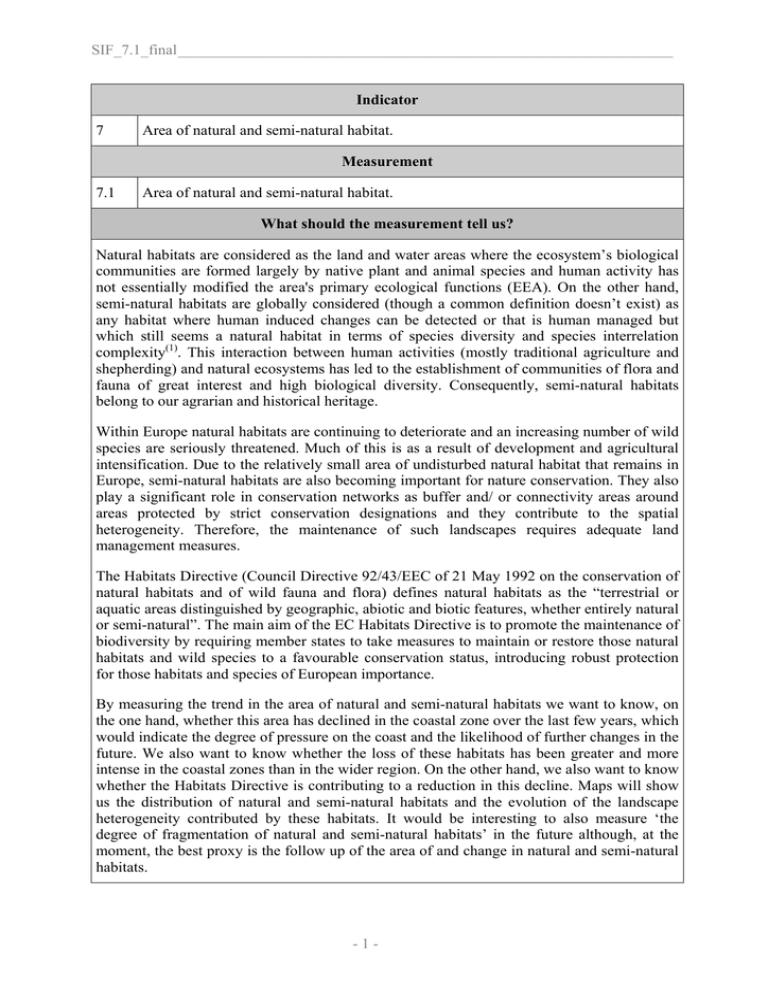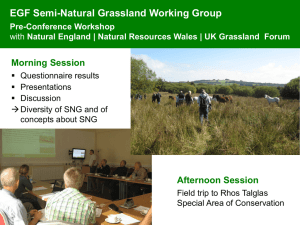SIF_7.1_final________________________________________________________________ 7 Area of natural and semi-natural habitat. 7.1
advertisement

SIF_7.1_final________________________________________________________________ Indicator 7 Area of natural and semi-natural habitat. Measurement 7.1 Area of natural and semi-natural habitat. What should the measurement tell us? Natural habitats are considered as the land and water areas where the ecosystem’s biological communities are formed largely by native plant and animal species and human activity has not essentially modified the area's primary ecological functions (EEA). On the other hand, semi-natural habitats are globally considered (though a common definition doesn’t exist) as any habitat where human induced changes can be detected or that is human managed but which still seems a natural habitat in terms of species diversity and species interrelation complexity(1). This interaction between human activities (mostly traditional agriculture and shepherding) and natural ecosystems has led to the establishment of communities of flora and fauna of great interest and high biological diversity. Consequently, semi-natural habitats belong to our agrarian and historical heritage. Within Europe natural habitats are continuing to deteriorate and an increasing number of wild species are seriously threatened. Much of this is as a result of development and agricultural intensification. Due to the relatively small area of undisturbed natural habitat that remains in Europe, semi-natural habitats are also becoming important for nature conservation. They also play a significant role in conservation networks as buffer and/ or connectivity areas around areas protected by strict conservation designations and they contribute to the spatial heterogeneity. Therefore, the maintenance of such landscapes requires adequate land management measures. The Habitats Directive (Council Directive 92/43/EEC of 21 May 1992 on the conservation of natural habitats and of wild fauna and flora) defines natural habitats as the “terrestrial or aquatic areas distinguished by geographic, abiotic and biotic features, whether entirely natural or semi-natural”. The main aim of the EC Habitats Directive is to promote the maintenance of biodiversity by requiring member states to take measures to maintain or restore those natural habitats and wild species to a favourable conservation status, introducing robust protection for those habitats and species of European importance. By measuring the trend in the area of natural and semi-natural habitats we want to know, on the one hand, whether this area has declined in the coastal zone over the last few years, which would indicate the degree of pressure on the coast and the likelihood of further changes in the future. We also want to know whether the loss of these habitats has been greater and more intense in the coastal zones than in the wider region. On the other hand, we also want to know whether the Habitats Directive is contributing to a reduction in this decline. Maps will show us the distribution of natural and semi-natural habitats and the evolution of the landscape heterogeneity contributed by these habitats. It would be interesting to also measure ‘the degree of fragmentation of natural and semi-natural habitats’ in the future although, at the moment, the best proxy is the follow up of the area of and change in natural and semi-natural habitats. -1- SIF_7.1_final________________________________________________________________ Parameters (i) Percentage of natural and semi-natural habitat in hectares in coastal NUTS 5 and in non-coastal NUTS 5. (ii) Percentage of natural and semi-natural habitat in hectares by distance from the coastline in 0-1 and 0-10km buffers. Coverage Spatial Temporal Coastal NUTS 5; non-coastal NUTS5, 0-1 Corine Land Cover datasets: 1995 and 2000 and 1-10km buffer from the coastline National land use surveys: at least three sampling points Data sources National land use surveys are preferable whenever available. When not, data are available from the Corine Land Cover datasets for 1990 and 2000. However, CLC does not cover all countries. There was no coverage in 1990 for Finland, Sweden, UK, Cyprus, Malta and Turkey. By 2000, coverage had extended to all of those countries with the exception of the UK and Turkey. Nevertheless, the lack of cover in 1990 means that comparison (with the past) cannot be made using CLC and in such cases must be substituted by national datasets. Land cover data are available from datasets for 1995 and 2000 from the CORINE programme. It is important to stress that area estimation generally cannot be a sub-product of mapping. In particular, estimating land cover area or land cover change area from thematic maps, such as CORINE Land Cover (CLC), simply by pixel counting or polygon measurement, generally leads to strongly biased results for two main reasons: 1) Geographic accuracy: the average estimated accuracy of CLC 1990 is 25 hectares and therefore the bias is expected to be significant for small landscape elements like ponds and small coastal lagoons. 2) Thematic accuracy: different types of photo-interpretation error are not random and generally do not compensate. Methodology (for the use of CLC but also applicable to national land use surveys) Steps 1 Products For the wider reference region(3), overlay NUTS 5 boundaries with CLC data (or national data) for both 1995 and 2000 or years available and clip polygons labelled with categories listed in note 2 (or corresponding categories defined as natural and semi-natural habitats in your national data) for each coastal NUTS 5. Add up -2- Area of natural and semi-natural habitat in hectares within each coastal NUTS 5 for CLC 1995 and 2000 (or each year available). SIF_7.1_final________________________________________________________________ (using GIS statistics function) the area of the polygons. 2 Repeat for each non-coastal NUTS 5. Area of natural and semi-natural habitat in hectares within each non-coastal NUTS 5 for CLC 1995 and 2000 (or each year available). 3 Get the total area of each coastal NUTS5. Area of each coastal NUTS5. 4 Add together the area of all coastal NUTS5. Total area of all coastal NUTS5. 5 Get the total area of each non-coastal NUTS5. Area of each non-coastal NUTS5. 6 Add together the area of all non-coastal NUTS5. Total area of all non-coastal NUTS5. 7 For each coastal NUTS 5, get the % area of % area of natural and semi-natural habitat natural and semi-natural habitats lost during lost during the period considered within the period considered, by subtracting the each coastal NUTS 5. Map 1. area in the last year available to the area in the first year available, then dividing the product by the area in the first year available and multiplying by 100. 8 Repeat step 7 for each non-coastal NUTS 5. % area of natural and semi-natural habitat lost during the period considered within each non-coastal NUTS 5. Map 1. All of the following steps should be taken for CLC 1990 and again for CLC 2000 (or for each year available if using national data) 9 Add together the area of natural and seminatural habitat for every coastal NUTS 5. 10 Divide the product of step 9 by the product of step 4 and multiply by 100. 11 Add together the area of natural and semi- natural habitat for every non-coastal NUTS 5. 12 Divide the product of step 11 by the product of step 6 and multiply by 100. 13 Overlay buffers of 0-1km and 0-10km distance from the coastline with CLC data (or your national data) and clip polygons labelled with categories listed in note 2 for -3- Total area of natural and semi-natural habitat within all coastal NUTS 5. Percentage of natural and semi-natural habitat within all coastal NUTS 5 Graph 1. Total area of natural and semi-natural habitat within all non-coastal NUTS 5. Percentage of natural and semi-natural habitat within all non-coastal NUTS 5 Graph 1. Total area of natural and semi-natural habitat within the 0-1km and 0-10km buffers. SIF_7.1_final________________________________________________________________ each buffer. Add up (using GIS statistics function) the area of the polygons selected in each buffer. 14 Overlay buffers of 0-1km and 0-10km with Total area of land within each buffer. CLC data (or national data) and obtain the total area of land for each buffer. 15 For each buffer, divide the product of step 13 Percentage of natural and semi-natural by the product of step 14 and multiply by 100. habitat within 0-1km and 0-10km buffers. Presentation of the data Map 1 For the wider reference region, map the loss of natural and semi-natural habitat in each coastal NUTS 5 and in each non-coastal NUTS 5, during the period considered. Graph 1 Bar chart showing the percentage of natural and semi-natural habitat in coastal and non-coastal NUTS 5 in 1995 and 2000 (or at equivalent sampling points if using national datasets). Percent of natural and semi-natural habitat in coastal and noncoastal NUTS5 Percent of natural and semi-natural habitat 50% 40% 30% 20% 10% 7,1% 6,1% 1,0% 0,9% 0% 1995 Bar chart showing the percentage of natural and semi-natural habitat in coastal buffers 0-1km and 010km, for both 1990 and 2000 (or at equivalent sampling points if using national datasets). Percent of natural and semi-natural habitat in 1 and 10 km coastal buffers 50% Percent of natural and semi-natural habitat Graph 2 coastal NUTS 5 non-coastal NUTS 5 2000 40% 30% 20% 10% 9,7% 9,0% 3,5% 3,4% 0% CLC1995 CLC2000 1km 10km Adding value to the data Aggregation and disaggregation The same methodology can be used to aggregate data at the provincial (NUTS 3), regional (NUTS 2) or national NUTS 0 levels. Notes -4- SIF_7.1_final________________________________________________________________ (1) Source: National Institute of Biodiversity in Costa Rica (2) If using Corine Land Cover data, select the following categories, which include natural and semi-natural habitats: 2.3. Pastures. 2.4. Heterogeneous agricultural areas. 3.1. Forests. 3.2. Scrub and/or herbaceous vegetation associations. 3.3. Open spaces with little or no vegetation. 4.1 Inland wetlands. 4.2 Coastal wetland. 5.1 Inland waters. 5.2 Marine waters. 2.3.1 Pastures . 2.4.3 Land principally occupied by agriculture, with significant areas of natural vegetation. 2.4.4 Agro-forestry areas . 3.1.1 Broad-leaved forest. 3.1.2 Coniferous forest. 3.1.3 Mixed forest. 3.2.1 Natural grasslands. 3.2.2 Moors and heathland . 3.2.3 Sclerophyllous vegetation. 3.2.4 Transitional woodland-shrub. 3.3.1 Beaches, dunes, sands. 3.3.2 Bare rocks. 3.3.3 Sparsely vegetated areas. 3.3.4 Burnt areas. 3.3.5 Glaciers and perpetual snow. 4.1.1 Inland marshes. 4.1.2 Peat bogs. 4.2.1 Salt marshes. 4.2.2 Salines. 4.2.3 Intertidal flats. 5.1.1 Water courses. 5.1.2 Water bodies. 5.2.1 Coastal lagoons. 5.2.2 Estuaries. (3) For many countries the Corine coastline does not coincide with the coastline defined by NUTS. In some cases the difference can be as much as two kilometres. It is possible to adjust CLC for this discontinuity. Limitations of the Indicator: Application of this indicator is constrained by several factors but these can mostly be overcome if resources and personnel are available. The main factor preventing the immediate and widespread application of this indicator is the scarcity of suitable time-series of land cover data. The reliability of evaluating the extent and uniqueness of the ecosystem depends on the detail, quality and compatibility of ecosystem classification applied across continuous terrestrial and marine areas. Ecosystem diversity distribution has not been mapped at an appropriate scale for many areas of high biological diversity. The indicator fails to account for variation in ecosystem status other than extent. Perturbations that do not affect total area will not be recognised through monitoring this indicator, nor will it be possible to anticipate likely future trends in ecosystem status through this indicator alone. -5-






